Analysis of HR Practices, Pay Gap, and Strategies at Aviva Insurance
VerifiedAdded on 2022/12/26
|11
|3955
|62
Report
AI Summary
This report provides a comprehensive analysis of the Human Resource Management (HRM) practices at Aviva Insurance. It begins with an introduction to talent management and its impact on employee performance. The report then explores the interplay between business and HR strategies, followed by an examination of recruitment channels and selection methods employed by Aviva. Performance management, reward management, and training and development programs are discussed, along with Aviva's equality and diversity policies. The report includes an analysis of the gender pay gap at Aviva, highlighting the trends from 2017 to 2020, and identifies environmental factors impacting HRM practices, such as the COVID-19 crisis, technological advancements, government regulations, and economic conditions. Finally, the report offers recommendations for the organization to address shortcomings, focusing on the gender pay gap and strategies to promote gender equality in pay and employment. The report emphasizes the importance of data-driven decision-making and strategic interventions to improve HR practices.
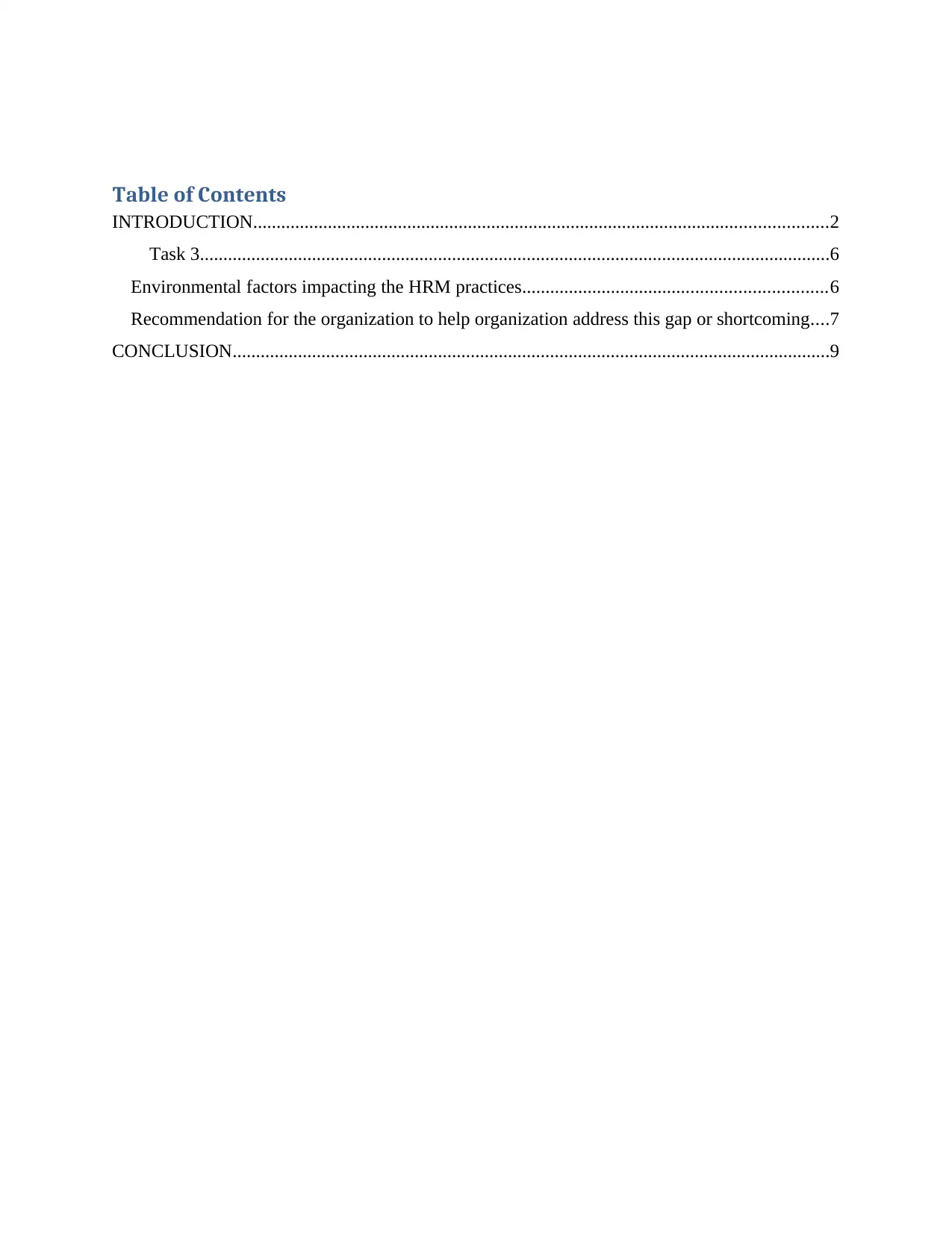
Table of Contents
INTRODUCTION...........................................................................................................................2
Task 3.......................................................................................................................................6
Environmental factors impacting the HRM practices.................................................................6
Recommendation for the organization to help organization address this gap or shortcoming....7
CONCLUSION................................................................................................................................9
INTRODUCTION...........................................................................................................................2
Task 3.......................................................................................................................................6
Environmental factors impacting the HRM practices.................................................................6
Recommendation for the organization to help organization address this gap or shortcoming....7
CONCLUSION................................................................................................................................9
Paraphrase This Document
Need a fresh take? Get an instant paraphrase of this document with our AI Paraphraser
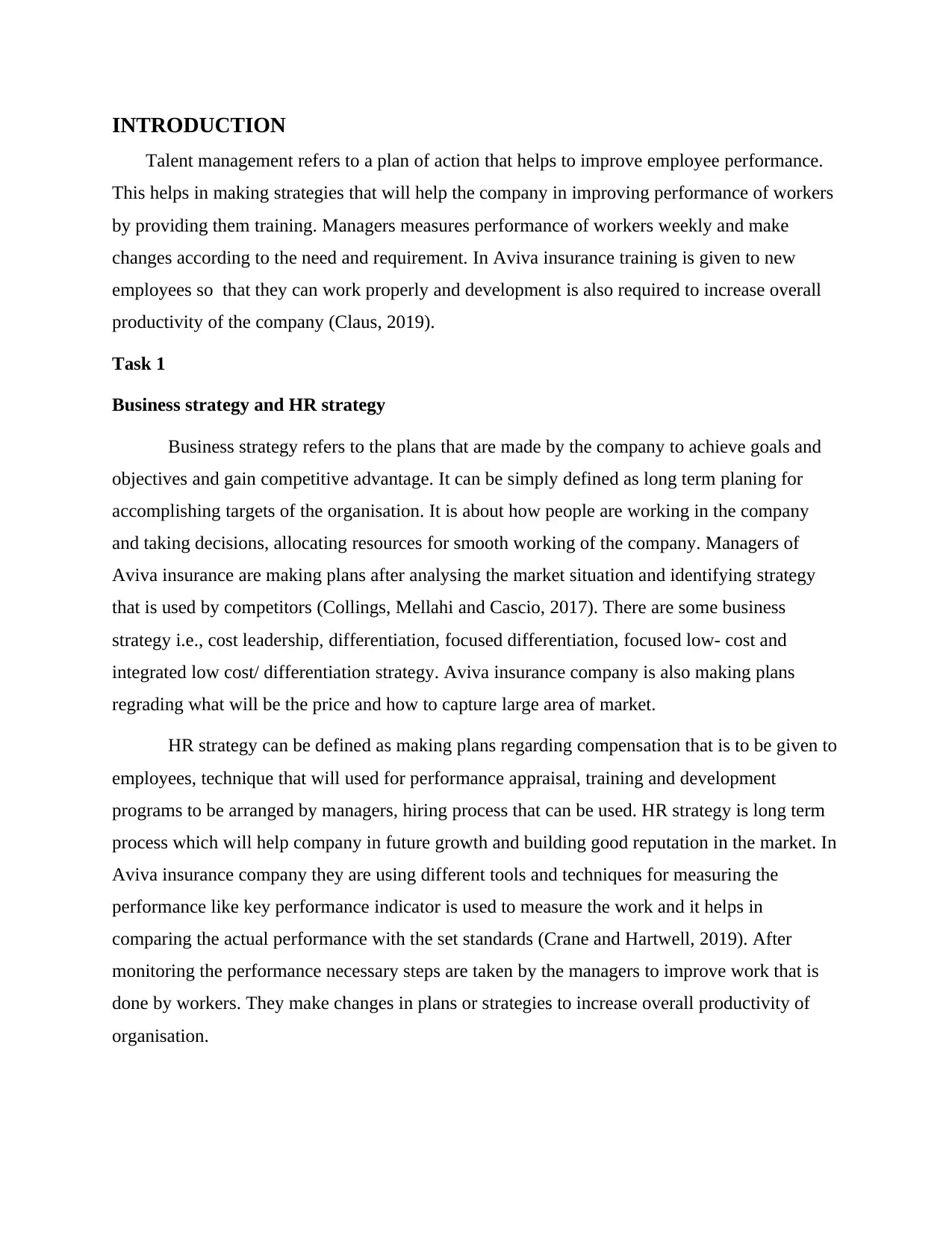
INTRODUCTION
Talent management refers to a plan of action that helps to improve employee performance.
This helps in making strategies that will help the company in improving performance of workers
by providing them training. Managers measures performance of workers weekly and make
changes according to the need and requirement. In Aviva insurance training is given to new
employees so that they can work properly and development is also required to increase overall
productivity of the company (Claus, 2019).
Task 1
Business strategy and HR strategy
Business strategy refers to the plans that are made by the company to achieve goals and
objectives and gain competitive advantage. It can be simply defined as long term planing for
accomplishing targets of the organisation. It is about how people are working in the company
and taking decisions, allocating resources for smooth working of the company. Managers of
Aviva insurance are making plans after analysing the market situation and identifying strategy
that is used by competitors (Collings, Mellahi and Cascio, 2017). There are some business
strategy i.e., cost leadership, differentiation, focused differentiation, focused low- cost and
integrated low cost/ differentiation strategy. Aviva insurance company is also making plans
regrading what will be the price and how to capture large area of market.
HR strategy can be defined as making plans regarding compensation that is to be given to
employees, technique that will used for performance appraisal, training and development
programs to be arranged by managers, hiring process that can be used. HR strategy is long term
process which will help company in future growth and building good reputation in the market. In
Aviva insurance company they are using different tools and techniques for measuring the
performance like key performance indicator is used to measure the work and it helps in
comparing the actual performance with the set standards (Crane and Hartwell, 2019). After
monitoring the performance necessary steps are taken by the managers to improve work that is
done by workers. They make changes in plans or strategies to increase overall productivity of
organisation.
Talent management refers to a plan of action that helps to improve employee performance.
This helps in making strategies that will help the company in improving performance of workers
by providing them training. Managers measures performance of workers weekly and make
changes according to the need and requirement. In Aviva insurance training is given to new
employees so that they can work properly and development is also required to increase overall
productivity of the company (Claus, 2019).
Task 1
Business strategy and HR strategy
Business strategy refers to the plans that are made by the company to achieve goals and
objectives and gain competitive advantage. It can be simply defined as long term planing for
accomplishing targets of the organisation. It is about how people are working in the company
and taking decisions, allocating resources for smooth working of the company. Managers of
Aviva insurance are making plans after analysing the market situation and identifying strategy
that is used by competitors (Collings, Mellahi and Cascio, 2017). There are some business
strategy i.e., cost leadership, differentiation, focused differentiation, focused low- cost and
integrated low cost/ differentiation strategy. Aviva insurance company is also making plans
regrading what will be the price and how to capture large area of market.
HR strategy can be defined as making plans regarding compensation that is to be given to
employees, technique that will used for performance appraisal, training and development
programs to be arranged by managers, hiring process that can be used. HR strategy is long term
process which will help company in future growth and building good reputation in the market. In
Aviva insurance company they are using different tools and techniques for measuring the
performance like key performance indicator is used to measure the work and it helps in
comparing the actual performance with the set standards (Crane and Hartwell, 2019). After
monitoring the performance necessary steps are taken by the managers to improve work that is
done by workers. They make changes in plans or strategies to increase overall productivity of
organisation.
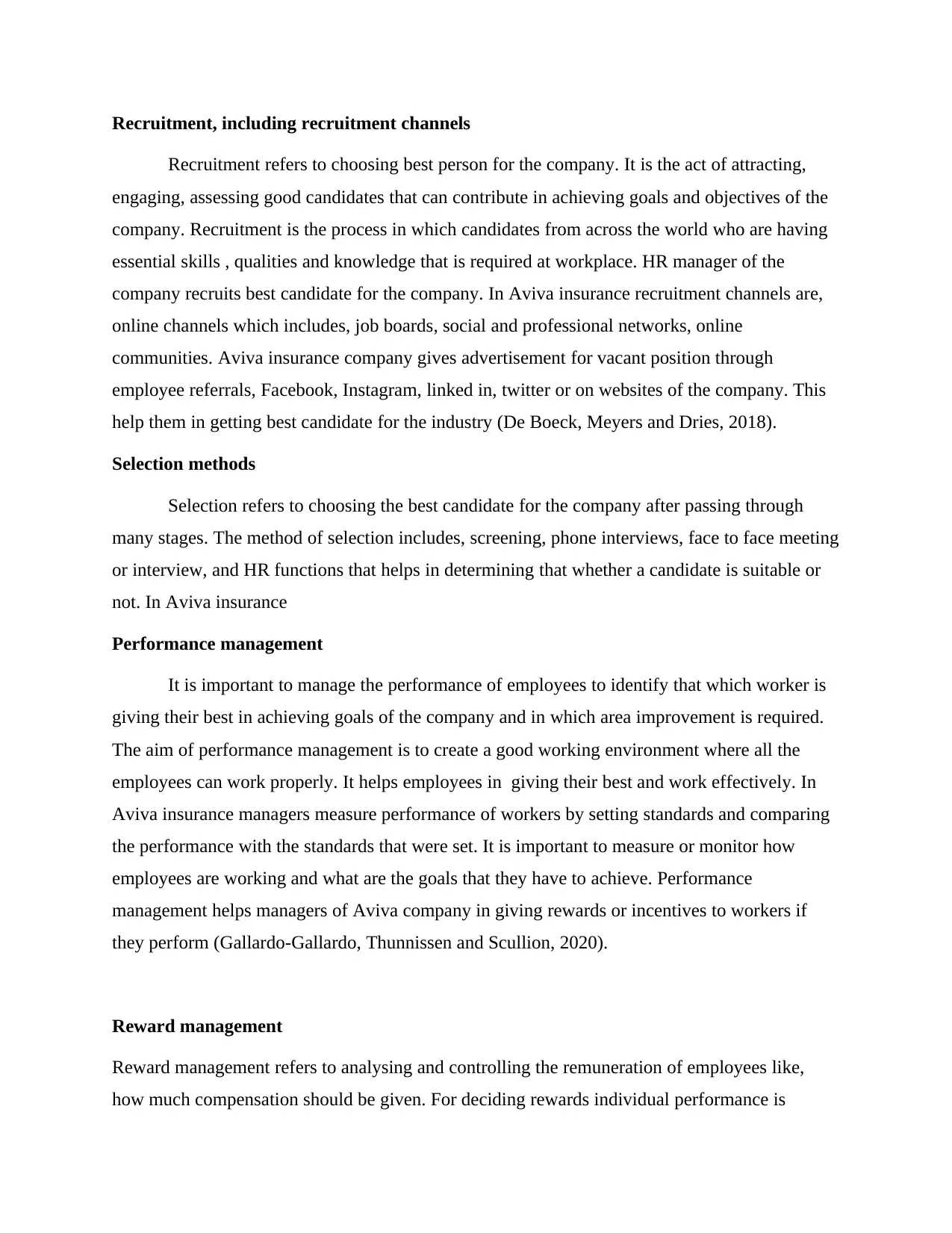
Recruitment, including recruitment channels
Recruitment refers to choosing best person for the company. It is the act of attracting,
engaging, assessing good candidates that can contribute in achieving goals and objectives of the
company. Recruitment is the process in which candidates from across the world who are having
essential skills , qualities and knowledge that is required at workplace. HR manager of the
company recruits best candidate for the company. In Aviva insurance recruitment channels are,
online channels which includes, job boards, social and professional networks, online
communities. Aviva insurance company gives advertisement for vacant position through
employee referrals, Facebook, Instagram, linked in, twitter or on websites of the company. This
help them in getting best candidate for the industry (De Boeck, Meyers and Dries, 2018).
Selection methods
Selection refers to choosing the best candidate for the company after passing through
many stages. The method of selection includes, screening, phone interviews, face to face meeting
or interview, and HR functions that helps in determining that whether a candidate is suitable or
not. In Aviva insurance
Performance management
It is important to manage the performance of employees to identify that which worker is
giving their best in achieving goals of the company and in which area improvement is required.
The aim of performance management is to create a good working environment where all the
employees can work properly. It helps employees in giving their best and work effectively. In
Aviva insurance managers measure performance of workers by setting standards and comparing
the performance with the standards that were set. It is important to measure or monitor how
employees are working and what are the goals that they have to achieve. Performance
management helps managers of Aviva company in giving rewards or incentives to workers if
they perform (Gallardo-Gallardo, Thunnissen and Scullion, 2020).
Reward management
Reward management refers to analysing and controlling the remuneration of employees like,
how much compensation should be given. For deciding rewards individual performance is
Recruitment refers to choosing best person for the company. It is the act of attracting,
engaging, assessing good candidates that can contribute in achieving goals and objectives of the
company. Recruitment is the process in which candidates from across the world who are having
essential skills , qualities and knowledge that is required at workplace. HR manager of the
company recruits best candidate for the company. In Aviva insurance recruitment channels are,
online channels which includes, job boards, social and professional networks, online
communities. Aviva insurance company gives advertisement for vacant position through
employee referrals, Facebook, Instagram, linked in, twitter or on websites of the company. This
help them in getting best candidate for the industry (De Boeck, Meyers and Dries, 2018).
Selection methods
Selection refers to choosing the best candidate for the company after passing through
many stages. The method of selection includes, screening, phone interviews, face to face meeting
or interview, and HR functions that helps in determining that whether a candidate is suitable or
not. In Aviva insurance
Performance management
It is important to manage the performance of employees to identify that which worker is
giving their best in achieving goals of the company and in which area improvement is required.
The aim of performance management is to create a good working environment where all the
employees can work properly. It helps employees in giving their best and work effectively. In
Aviva insurance managers measure performance of workers by setting standards and comparing
the performance with the standards that were set. It is important to measure or monitor how
employees are working and what are the goals that they have to achieve. Performance
management helps managers of Aviva company in giving rewards or incentives to workers if
they perform (Gallardo-Gallardo, Thunnissen and Scullion, 2020).
Reward management
Reward management refers to analysing and controlling the remuneration of employees like,
how much compensation should be given. For deciding rewards individual performance is
⊘ This is a preview!⊘
Do you want full access?
Subscribe today to unlock all pages.

Trusted by 1+ million students worldwide
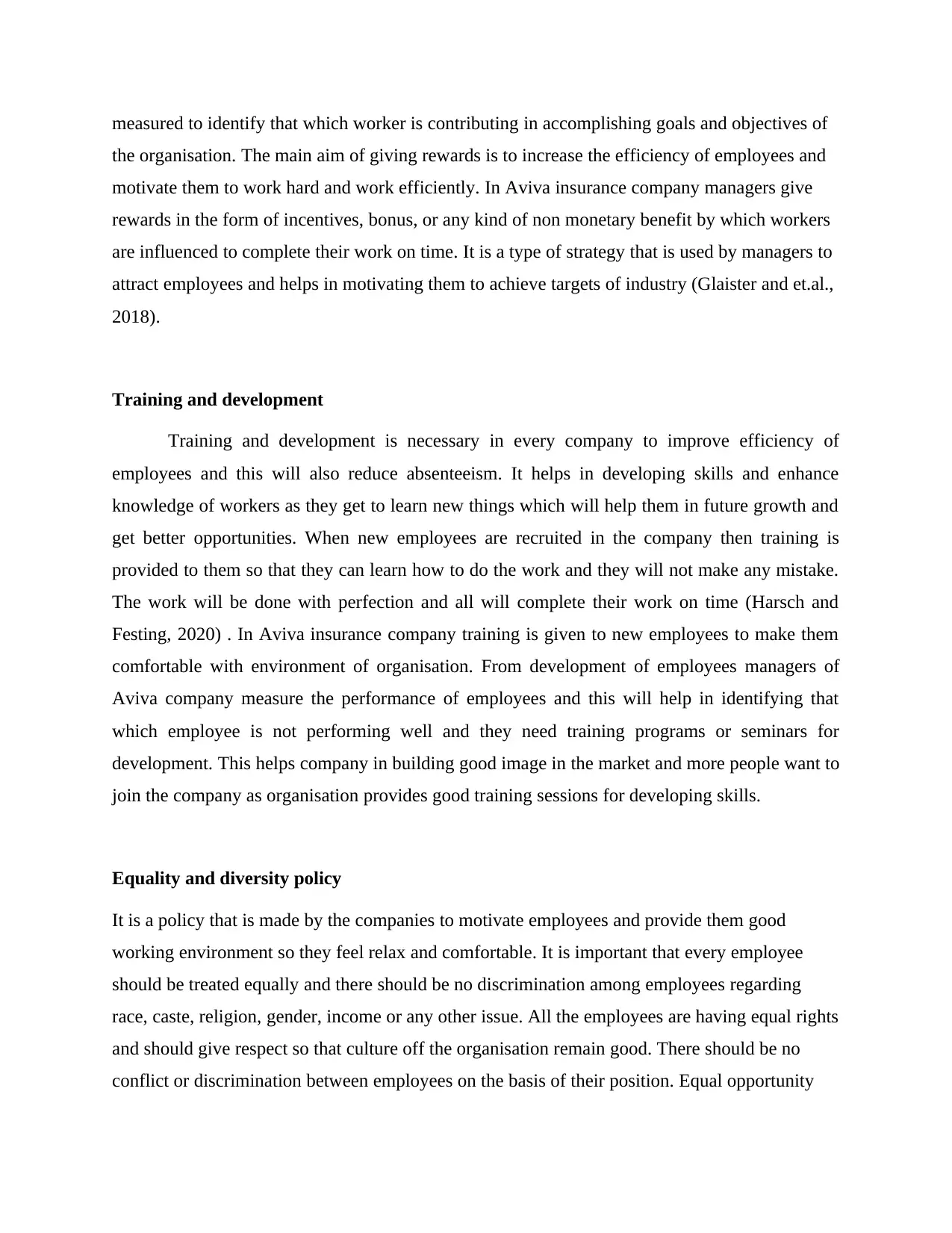
measured to identify that which worker is contributing in accomplishing goals and objectives of
the organisation. The main aim of giving rewards is to increase the efficiency of employees and
motivate them to work hard and work efficiently. In Aviva insurance company managers give
rewards in the form of incentives, bonus, or any kind of non monetary benefit by which workers
are influenced to complete their work on time. It is a type of strategy that is used by managers to
attract employees and helps in motivating them to achieve targets of industry (Glaister and et.al.,
2018).
Training and development
Training and development is necessary in every company to improve efficiency of
employees and this will also reduce absenteeism. It helps in developing skills and enhance
knowledge of workers as they get to learn new things which will help them in future growth and
get better opportunities. When new employees are recruited in the company then training is
provided to them so that they can learn how to do the work and they will not make any mistake.
The work will be done with perfection and all will complete their work on time (Harsch and
Festing, 2020) . In Aviva insurance company training is given to new employees to make them
comfortable with environment of organisation. From development of employees managers of
Aviva company measure the performance of employees and this will help in identifying that
which employee is not performing well and they need training programs or seminars for
development. This helps company in building good image in the market and more people want to
join the company as organisation provides good training sessions for developing skills.
Equality and diversity policy
It is a policy that is made by the companies to motivate employees and provide them good
working environment so they feel relax and comfortable. It is important that every employee
should be treated equally and there should be no discrimination among employees regarding
race, caste, religion, gender, income or any other issue. All the employees are having equal rights
and should give respect so that culture off the organisation remain good. There should be no
conflict or discrimination between employees on the basis of their position. Equal opportunity
the organisation. The main aim of giving rewards is to increase the efficiency of employees and
motivate them to work hard and work efficiently. In Aviva insurance company managers give
rewards in the form of incentives, bonus, or any kind of non monetary benefit by which workers
are influenced to complete their work on time. It is a type of strategy that is used by managers to
attract employees and helps in motivating them to achieve targets of industry (Glaister and et.al.,
2018).
Training and development
Training and development is necessary in every company to improve efficiency of
employees and this will also reduce absenteeism. It helps in developing skills and enhance
knowledge of workers as they get to learn new things which will help them in future growth and
get better opportunities. When new employees are recruited in the company then training is
provided to them so that they can learn how to do the work and they will not make any mistake.
The work will be done with perfection and all will complete their work on time (Harsch and
Festing, 2020) . In Aviva insurance company training is given to new employees to make them
comfortable with environment of organisation. From development of employees managers of
Aviva company measure the performance of employees and this will help in identifying that
which employee is not performing well and they need training programs or seminars for
development. This helps company in building good image in the market and more people want to
join the company as organisation provides good training sessions for developing skills.
Equality and diversity policy
It is a policy that is made by the companies to motivate employees and provide them good
working environment so they feel relax and comfortable. It is important that every employee
should be treated equally and there should be no discrimination among employees regarding
race, caste, religion, gender, income or any other issue. All the employees are having equal rights
and should give respect so that culture off the organisation remain good. There should be no
conflict or discrimination between employees on the basis of their position. Equal opportunity
Paraphrase This Document
Need a fresh take? Get an instant paraphrase of this document with our AI Paraphraser
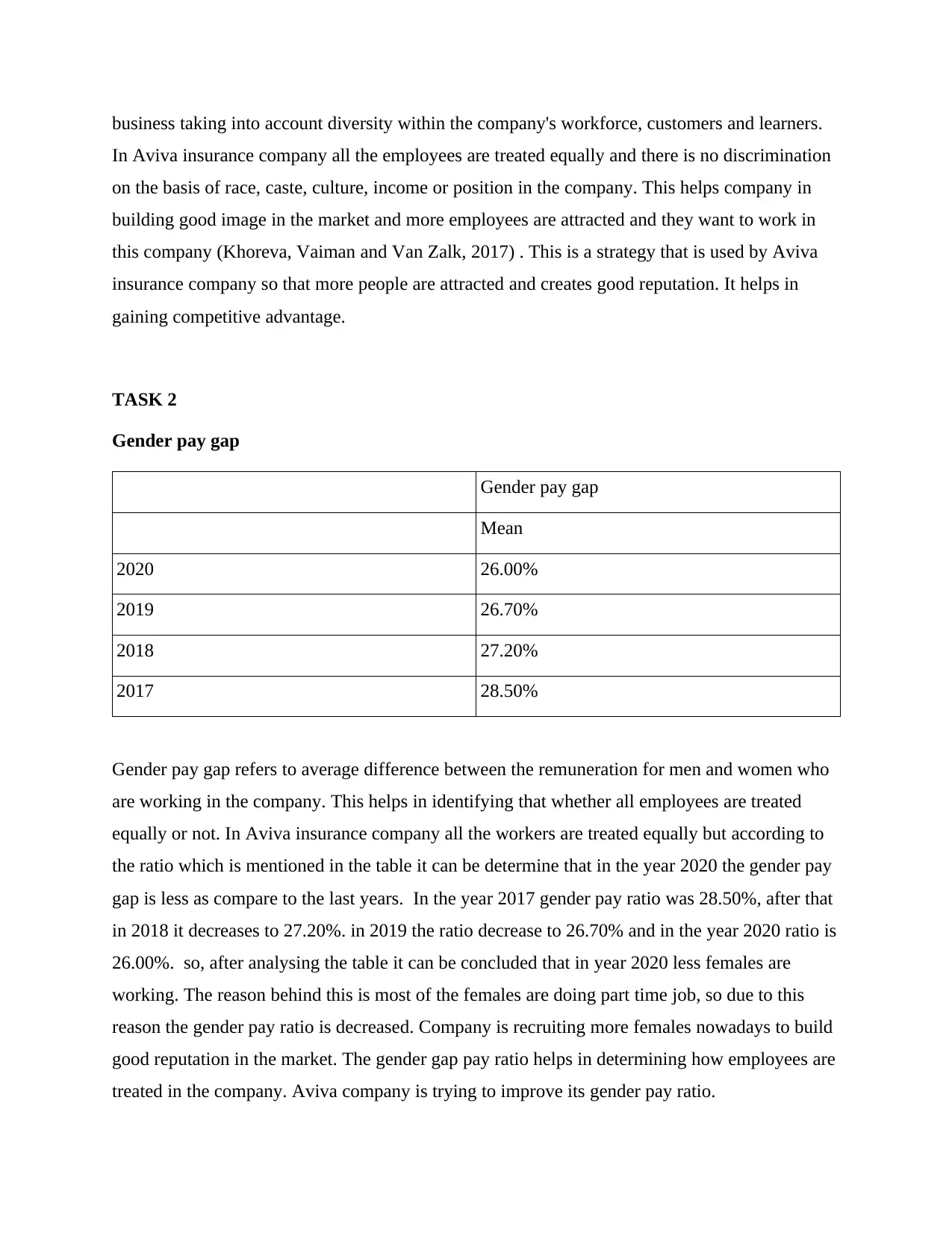
business taking into account diversity within the company's workforce, customers and learners.
In Aviva insurance company all the employees are treated equally and there is no discrimination
on the basis of race, caste, culture, income or position in the company. This helps company in
building good image in the market and more employees are attracted and they want to work in
this company (Khoreva, Vaiman and Van Zalk, 2017) . This is a strategy that is used by Aviva
insurance company so that more people are attracted and creates good reputation. It helps in
gaining competitive advantage.
TASK 2
Gender pay gap
Gender pay gap
Mean
2020 26.00%
2019 26.70%
2018 27.20%
2017 28.50%
Gender pay gap refers to average difference between the remuneration for men and women who
are working in the company. This helps in identifying that whether all employees are treated
equally or not. In Aviva insurance company all the workers are treated equally but according to
the ratio which is mentioned in the table it can be determine that in the year 2020 the gender pay
gap is less as compare to the last years. In the year 2017 gender pay ratio was 28.50%, after that
in 2018 it decreases to 27.20%. in 2019 the ratio decrease to 26.70% and in the year 2020 ratio is
26.00%. so, after analysing the table it can be concluded that in year 2020 less females are
working. The reason behind this is most of the females are doing part time job, so due to this
reason the gender pay ratio is decreased. Company is recruiting more females nowadays to build
good reputation in the market. The gender gap pay ratio helps in determining how employees are
treated in the company. Aviva company is trying to improve its gender pay ratio.
In Aviva insurance company all the employees are treated equally and there is no discrimination
on the basis of race, caste, culture, income or position in the company. This helps company in
building good image in the market and more employees are attracted and they want to work in
this company (Khoreva, Vaiman and Van Zalk, 2017) . This is a strategy that is used by Aviva
insurance company so that more people are attracted and creates good reputation. It helps in
gaining competitive advantage.
TASK 2
Gender pay gap
Gender pay gap
Mean
2020 26.00%
2019 26.70%
2018 27.20%
2017 28.50%
Gender pay gap refers to average difference between the remuneration for men and women who
are working in the company. This helps in identifying that whether all employees are treated
equally or not. In Aviva insurance company all the workers are treated equally but according to
the ratio which is mentioned in the table it can be determine that in the year 2020 the gender pay
gap is less as compare to the last years. In the year 2017 gender pay ratio was 28.50%, after that
in 2018 it decreases to 27.20%. in 2019 the ratio decrease to 26.70% and in the year 2020 ratio is
26.00%. so, after analysing the table it can be concluded that in year 2020 less females are
working. The reason behind this is most of the females are doing part time job, so due to this
reason the gender pay ratio is decreased. Company is recruiting more females nowadays to build
good reputation in the market. The gender gap pay ratio helps in determining how employees are
treated in the company. Aviva company is trying to improve its gender pay ratio.
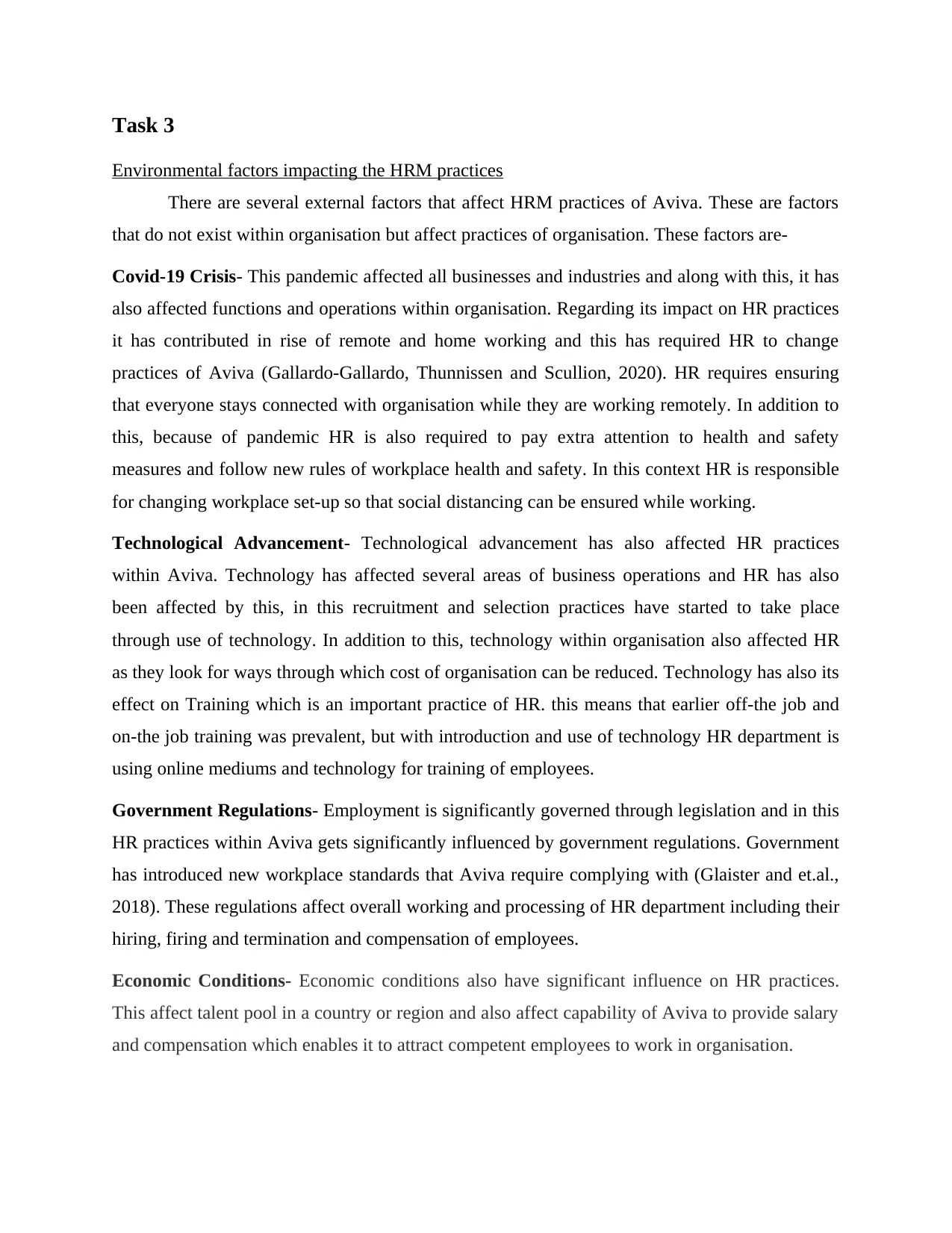
Task 3
Environmental factors impacting the HRM practices
There are several external factors that affect HRM practices of Aviva. These are factors
that do not exist within organisation but affect practices of organisation. These factors are-
Covid-19 Crisis- This pandemic affected all businesses and industries and along with this, it has
also affected functions and operations within organisation. Regarding its impact on HR practices
it has contributed in rise of remote and home working and this has required HR to change
practices of Aviva (Gallardo-Gallardo, Thunnissen and Scullion, 2020). HR requires ensuring
that everyone stays connected with organisation while they are working remotely. In addition to
this, because of pandemic HR is also required to pay extra attention to health and safety
measures and follow new rules of workplace health and safety. In this context HR is responsible
for changing workplace set-up so that social distancing can be ensured while working.
Technological Advancement- Technological advancement has also affected HR practices
within Aviva. Technology has affected several areas of business operations and HR has also
been affected by this, in this recruitment and selection practices have started to take place
through use of technology. In addition to this, technology within organisation also affected HR
as they look for ways through which cost of organisation can be reduced. Technology has also its
effect on Training which is an important practice of HR. this means that earlier off-the job and
on-the job training was prevalent, but with introduction and use of technology HR department is
using online mediums and technology for training of employees.
Government Regulations- Employment is significantly governed through legislation and in this
HR practices within Aviva gets significantly influenced by government regulations. Government
has introduced new workplace standards that Aviva require complying with (Glaister and et.al.,
2018). These regulations affect overall working and processing of HR department including their
hiring, firing and termination and compensation of employees.
Economic Conditions- Economic conditions also have significant influence on HR practices.
This affect talent pool in a country or region and also affect capability of Aviva to provide salary
and compensation which enables it to attract competent employees to work in organisation.
Environmental factors impacting the HRM practices
There are several external factors that affect HRM practices of Aviva. These are factors
that do not exist within organisation but affect practices of organisation. These factors are-
Covid-19 Crisis- This pandemic affected all businesses and industries and along with this, it has
also affected functions and operations within organisation. Regarding its impact on HR practices
it has contributed in rise of remote and home working and this has required HR to change
practices of Aviva (Gallardo-Gallardo, Thunnissen and Scullion, 2020). HR requires ensuring
that everyone stays connected with organisation while they are working remotely. In addition to
this, because of pandemic HR is also required to pay extra attention to health and safety
measures and follow new rules of workplace health and safety. In this context HR is responsible
for changing workplace set-up so that social distancing can be ensured while working.
Technological Advancement- Technological advancement has also affected HR practices
within Aviva. Technology has affected several areas of business operations and HR has also
been affected by this, in this recruitment and selection practices have started to take place
through use of technology. In addition to this, technology within organisation also affected HR
as they look for ways through which cost of organisation can be reduced. Technology has also its
effect on Training which is an important practice of HR. this means that earlier off-the job and
on-the job training was prevalent, but with introduction and use of technology HR department is
using online mediums and technology for training of employees.
Government Regulations- Employment is significantly governed through legislation and in this
HR practices within Aviva gets significantly influenced by government regulations. Government
has introduced new workplace standards that Aviva require complying with (Glaister and et.al.,
2018). These regulations affect overall working and processing of HR department including their
hiring, firing and termination and compensation of employees.
Economic Conditions- Economic conditions also have significant influence on HR practices.
This affect talent pool in a country or region and also affect capability of Aviva to provide salary
and compensation which enables it to attract competent employees to work in organisation.
⊘ This is a preview!⊘
Do you want full access?
Subscribe today to unlock all pages.

Trusted by 1+ million students worldwide
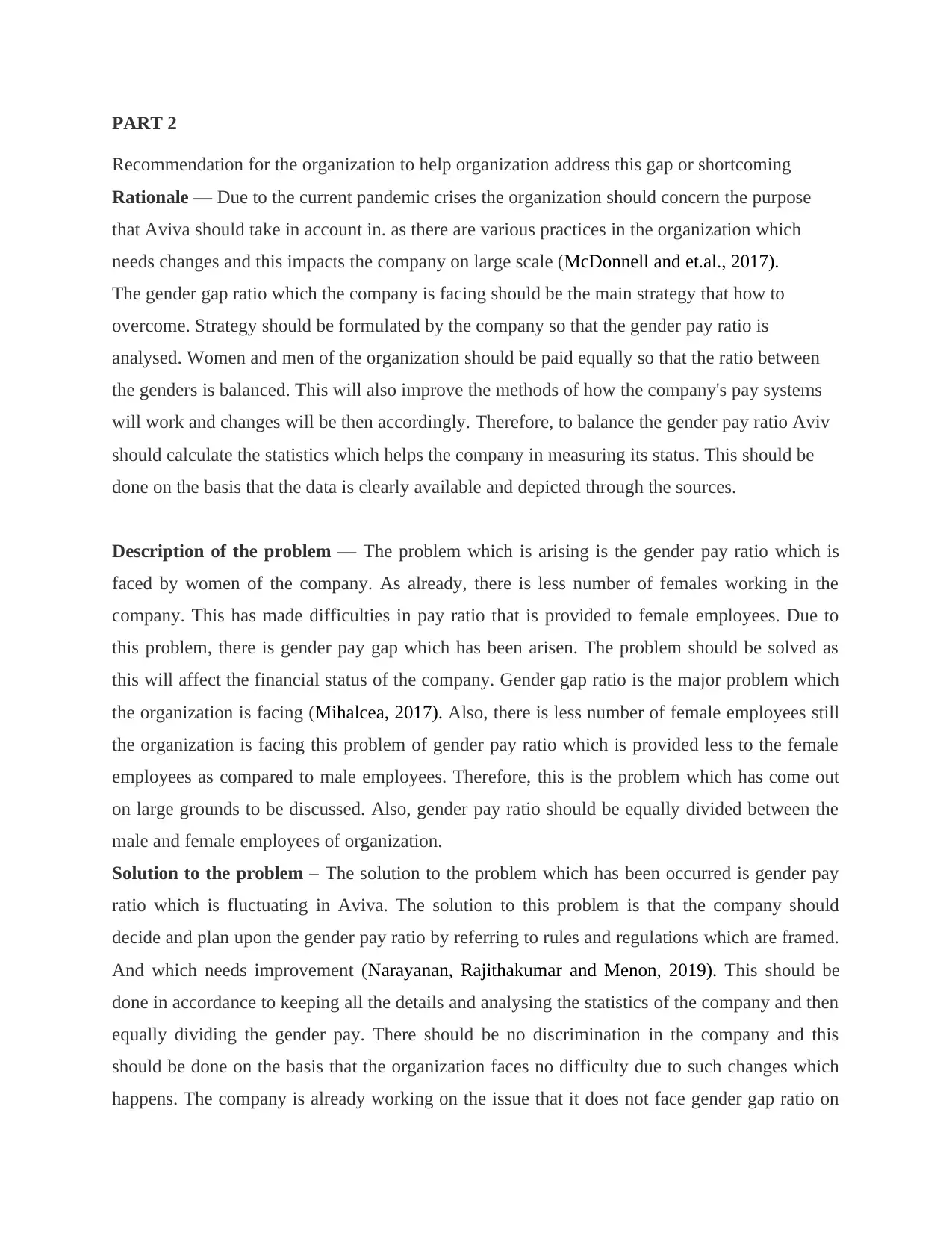
PART 2
Recommendation for the organization to help organization address this gap or shortcoming
Rationale — Due to the current pandemic crises the organization should concern the purpose
that Aviva should take in account in. as there are various practices in the organization which
needs changes and this impacts the company on large scale (McDonnell and et.al., 2017).
The gender gap ratio which the company is facing should be the main strategy that how to
overcome. Strategy should be formulated by the company so that the gender pay ratio is
analysed. Women and men of the organization should be paid equally so that the ratio between
the genders is balanced. This will also improve the methods of how the company's pay systems
will work and changes will be then accordingly. Therefore, to balance the gender pay ratio Aviv
should calculate the statistics which helps the company in measuring its status. This should be
done on the basis that the data is clearly available and depicted through the sources.
Description of the problem — The problem which is arising is the gender pay ratio which is
faced by women of the company. As already, there is less number of females working in the
company. This has made difficulties in pay ratio that is provided to female employees. Due to
this problem, there is gender pay gap which has been arisen. The problem should be solved as
this will affect the financial status of the company. Gender gap ratio is the major problem which
the organization is facing (Mihalcea, 2017). Also, there is less number of female employees still
the organization is facing this problem of gender pay ratio which is provided less to the female
employees as compared to male employees. Therefore, this is the problem which has come out
on large grounds to be discussed. Also, gender pay ratio should be equally divided between the
male and female employees of organization.
Solution to the problem – The solution to the problem which has been occurred is gender pay
ratio which is fluctuating in Aviva. The solution to this problem is that the company should
decide and plan upon the gender pay ratio by referring to rules and regulations which are framed.
And which needs improvement (Narayanan, Rajithakumar and Menon, 2019). This should be
done in accordance to keeping all the details and analysing the statistics of the company and then
equally dividing the gender pay. There should be no discrimination in the company and this
should be done on the basis that the organization faces no difficulty due to such changes which
happens. The company is already working on the issue that it does not face gender gap ratio on
Recommendation for the organization to help organization address this gap or shortcoming
Rationale — Due to the current pandemic crises the organization should concern the purpose
that Aviva should take in account in. as there are various practices in the organization which
needs changes and this impacts the company on large scale (McDonnell and et.al., 2017).
The gender gap ratio which the company is facing should be the main strategy that how to
overcome. Strategy should be formulated by the company so that the gender pay ratio is
analysed. Women and men of the organization should be paid equally so that the ratio between
the genders is balanced. This will also improve the methods of how the company's pay systems
will work and changes will be then accordingly. Therefore, to balance the gender pay ratio Aviv
should calculate the statistics which helps the company in measuring its status. This should be
done on the basis that the data is clearly available and depicted through the sources.
Description of the problem — The problem which is arising is the gender pay ratio which is
faced by women of the company. As already, there is less number of females working in the
company. This has made difficulties in pay ratio that is provided to female employees. Due to
this problem, there is gender pay gap which has been arisen. The problem should be solved as
this will affect the financial status of the company. Gender gap ratio is the major problem which
the organization is facing (Mihalcea, 2017). Also, there is less number of female employees still
the organization is facing this problem of gender pay ratio which is provided less to the female
employees as compared to male employees. Therefore, this is the problem which has come out
on large grounds to be discussed. Also, gender pay ratio should be equally divided between the
male and female employees of organization.
Solution to the problem – The solution to the problem which has been occurred is gender pay
ratio which is fluctuating in Aviva. The solution to this problem is that the company should
decide and plan upon the gender pay ratio by referring to rules and regulations which are framed.
And which needs improvement (Narayanan, Rajithakumar and Menon, 2019). This should be
done in accordance to keeping all the details and analysing the statistics of the company and then
equally dividing the gender pay. There should be no discrimination in the company and this
should be done on the basis that the organization faces no difficulty due to such changes which
happens. The company is already working on the issue that it does not face gender gap ratio on
Paraphrase This Document
Need a fresh take? Get an instant paraphrase of this document with our AI Paraphraser
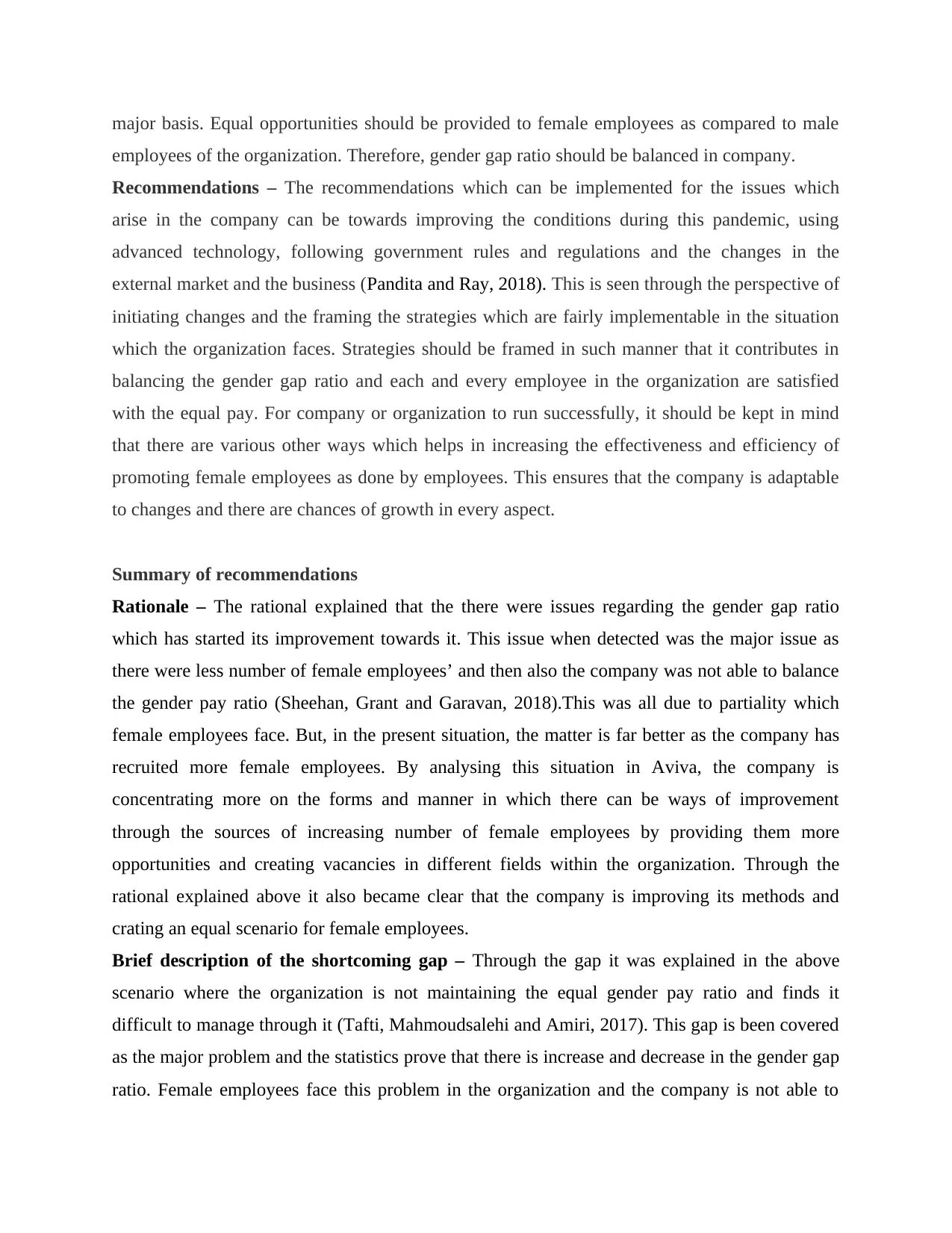
major basis. Equal opportunities should be provided to female employees as compared to male
employees of the organization. Therefore, gender gap ratio should be balanced in company.
Recommendations – The recommendations which can be implemented for the issues which
arise in the company can be towards improving the conditions during this pandemic, using
advanced technology, following government rules and regulations and the changes in the
external market and the business (Pandita and Ray, 2018). This is seen through the perspective of
initiating changes and the framing the strategies which are fairly implementable in the situation
which the organization faces. Strategies should be framed in such manner that it contributes in
balancing the gender gap ratio and each and every employee in the organization are satisfied
with the equal pay. For company or organization to run successfully, it should be kept in mind
that there are various other ways which helps in increasing the effectiveness and efficiency of
promoting female employees as done by employees. This ensures that the company is adaptable
to changes and there are chances of growth in every aspect.
Summary of recommendations
Rationale – The rational explained that the there were issues regarding the gender gap ratio
which has started its improvement towards it. This issue when detected was the major issue as
there were less number of female employees’ and then also the company was not able to balance
the gender pay ratio (Sheehan, Grant and Garavan, 2018).This was all due to partiality which
female employees face. But, in the present situation, the matter is far better as the company has
recruited more female employees. By analysing this situation in Aviva, the company is
concentrating more on the forms and manner in which there can be ways of improvement
through the sources of increasing number of female employees by providing them more
opportunities and creating vacancies in different fields within the organization. Through the
rational explained above it also became clear that the company is improving its methods and
crating an equal scenario for female employees.
Brief description of the shortcoming gap – Through the gap it was explained in the above
scenario where the organization is not maintaining the equal gender pay ratio and finds it
difficult to manage through it (Tafti, Mahmoudsalehi and Amiri, 2017). This gap is been covered
as the major problem and the statistics prove that there is increase and decrease in the gender gap
ratio. Female employees face this problem in the organization and the company is not able to
employees of the organization. Therefore, gender gap ratio should be balanced in company.
Recommendations – The recommendations which can be implemented for the issues which
arise in the company can be towards improving the conditions during this pandemic, using
advanced technology, following government rules and regulations and the changes in the
external market and the business (Pandita and Ray, 2018). This is seen through the perspective of
initiating changes and the framing the strategies which are fairly implementable in the situation
which the organization faces. Strategies should be framed in such manner that it contributes in
balancing the gender gap ratio and each and every employee in the organization are satisfied
with the equal pay. For company or organization to run successfully, it should be kept in mind
that there are various other ways which helps in increasing the effectiveness and efficiency of
promoting female employees as done by employees. This ensures that the company is adaptable
to changes and there are chances of growth in every aspect.
Summary of recommendations
Rationale – The rational explained that the there were issues regarding the gender gap ratio
which has started its improvement towards it. This issue when detected was the major issue as
there were less number of female employees’ and then also the company was not able to balance
the gender pay ratio (Sheehan, Grant and Garavan, 2018).This was all due to partiality which
female employees face. But, in the present situation, the matter is far better as the company has
recruited more female employees. By analysing this situation in Aviva, the company is
concentrating more on the forms and manner in which there can be ways of improvement
through the sources of increasing number of female employees by providing them more
opportunities and creating vacancies in different fields within the organization. Through the
rational explained above it also became clear that the company is improving its methods and
crating an equal scenario for female employees.
Brief description of the shortcoming gap – Through the gap it was explained in the above
scenario where the organization is not maintaining the equal gender pay ratio and finds it
difficult to manage through it (Tafti, Mahmoudsalehi and Amiri, 2017). This gap is been covered
as the major problem and the statistics prove that there is increase and decrease in the gender gap
ratio. Female employees face this problem in the organization and the company is not able to
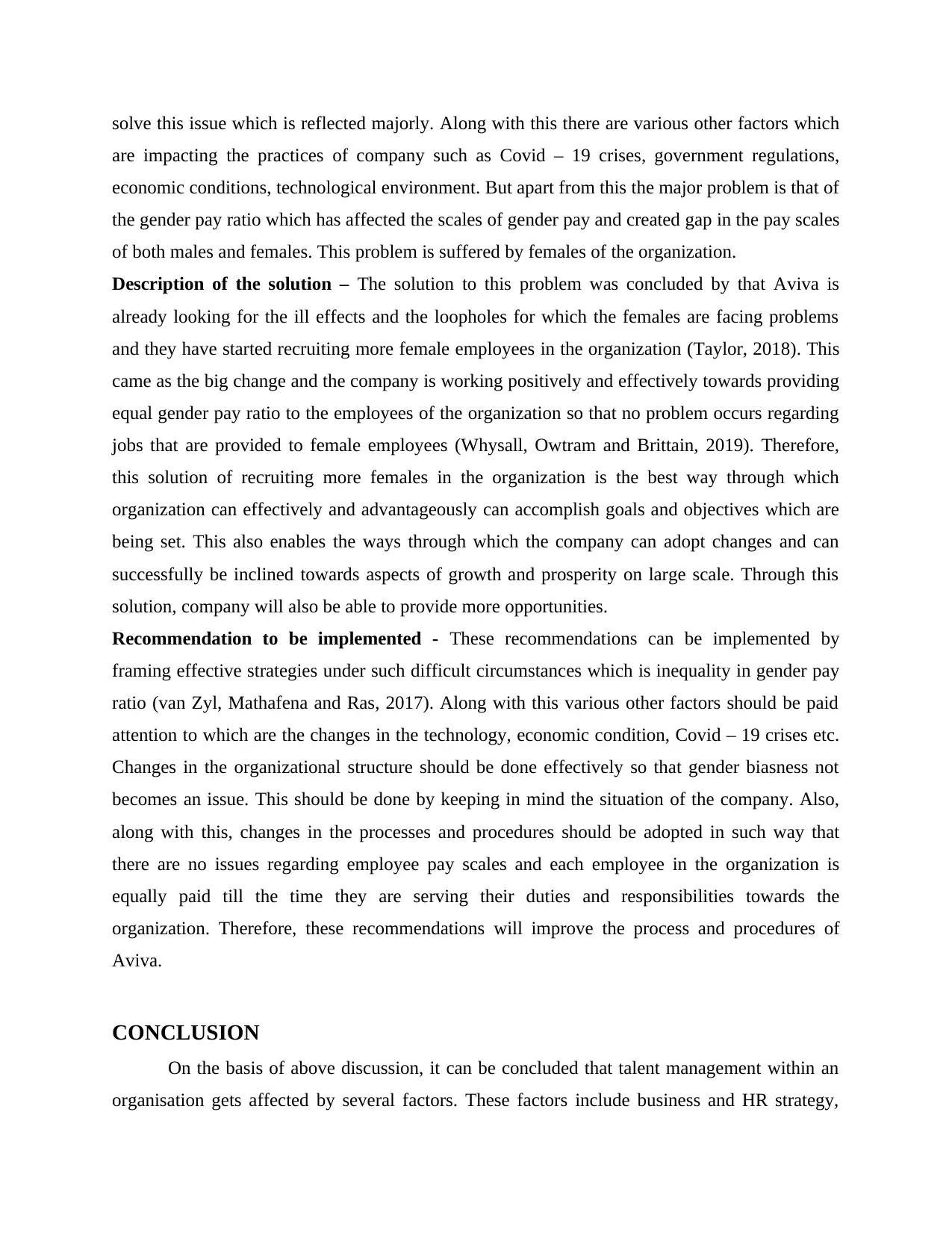
solve this issue which is reflected majorly. Along with this there are various other factors which
are impacting the practices of company such as Covid – 19 crises, government regulations,
economic conditions, technological environment. But apart from this the major problem is that of
the gender pay ratio which has affected the scales of gender pay and created gap in the pay scales
of both males and females. This problem is suffered by females of the organization.
Description of the solution – The solution to this problem was concluded by that Aviva is
already looking for the ill effects and the loopholes for which the females are facing problems
and they have started recruiting more female employees in the organization (Taylor, 2018). This
came as the big change and the company is working positively and effectively towards providing
equal gender pay ratio to the employees of the organization so that no problem occurs regarding
jobs that are provided to female employees (Whysall, Owtram and Brittain, 2019). Therefore,
this solution of recruiting more females in the organization is the best way through which
organization can effectively and advantageously can accomplish goals and objectives which are
being set. This also enables the ways through which the company can adopt changes and can
successfully be inclined towards aspects of growth and prosperity on large scale. Through this
solution, company will also be able to provide more opportunities.
Recommendation to be implemented - These recommendations can be implemented by
framing effective strategies under such difficult circumstances which is inequality in gender pay
ratio (van Zyl, Mathafena and Ras, 2017). Along with this various other factors should be paid
attention to which are the changes in the technology, economic condition, Covid – 19 crises etc.
Changes in the organizational structure should be done effectively so that gender biasness not
becomes an issue. This should be done by keeping in mind the situation of the company. Also,
along with this, changes in the processes and procedures should be adopted in such way that
there are no issues regarding employee pay scales and each employee in the organization is
equally paid till the time they are serving their duties and responsibilities towards the
organization. Therefore, these recommendations will improve the process and procedures of
Aviva.
CONCLUSION
On the basis of above discussion, it can be concluded that talent management within an
organisation gets affected by several factors. These factors include business and HR strategy,
are impacting the practices of company such as Covid – 19 crises, government regulations,
economic conditions, technological environment. But apart from this the major problem is that of
the gender pay ratio which has affected the scales of gender pay and created gap in the pay scales
of both males and females. This problem is suffered by females of the organization.
Description of the solution – The solution to this problem was concluded by that Aviva is
already looking for the ill effects and the loopholes for which the females are facing problems
and they have started recruiting more female employees in the organization (Taylor, 2018). This
came as the big change and the company is working positively and effectively towards providing
equal gender pay ratio to the employees of the organization so that no problem occurs regarding
jobs that are provided to female employees (Whysall, Owtram and Brittain, 2019). Therefore,
this solution of recruiting more females in the organization is the best way through which
organization can effectively and advantageously can accomplish goals and objectives which are
being set. This also enables the ways through which the company can adopt changes and can
successfully be inclined towards aspects of growth and prosperity on large scale. Through this
solution, company will also be able to provide more opportunities.
Recommendation to be implemented - These recommendations can be implemented by
framing effective strategies under such difficult circumstances which is inequality in gender pay
ratio (van Zyl, Mathafena and Ras, 2017). Along with this various other factors should be paid
attention to which are the changes in the technology, economic condition, Covid – 19 crises etc.
Changes in the organizational structure should be done effectively so that gender biasness not
becomes an issue. This should be done by keeping in mind the situation of the company. Also,
along with this, changes in the processes and procedures should be adopted in such way that
there are no issues regarding employee pay scales and each employee in the organization is
equally paid till the time they are serving their duties and responsibilities towards the
organization. Therefore, these recommendations will improve the process and procedures of
Aviva.
CONCLUSION
On the basis of above discussion, it can be concluded that talent management within an
organisation gets affected by several factors. These factors include business and HR strategy,
⊘ This is a preview!⊘
Do you want full access?
Subscribe today to unlock all pages.

Trusted by 1+ million students worldwide
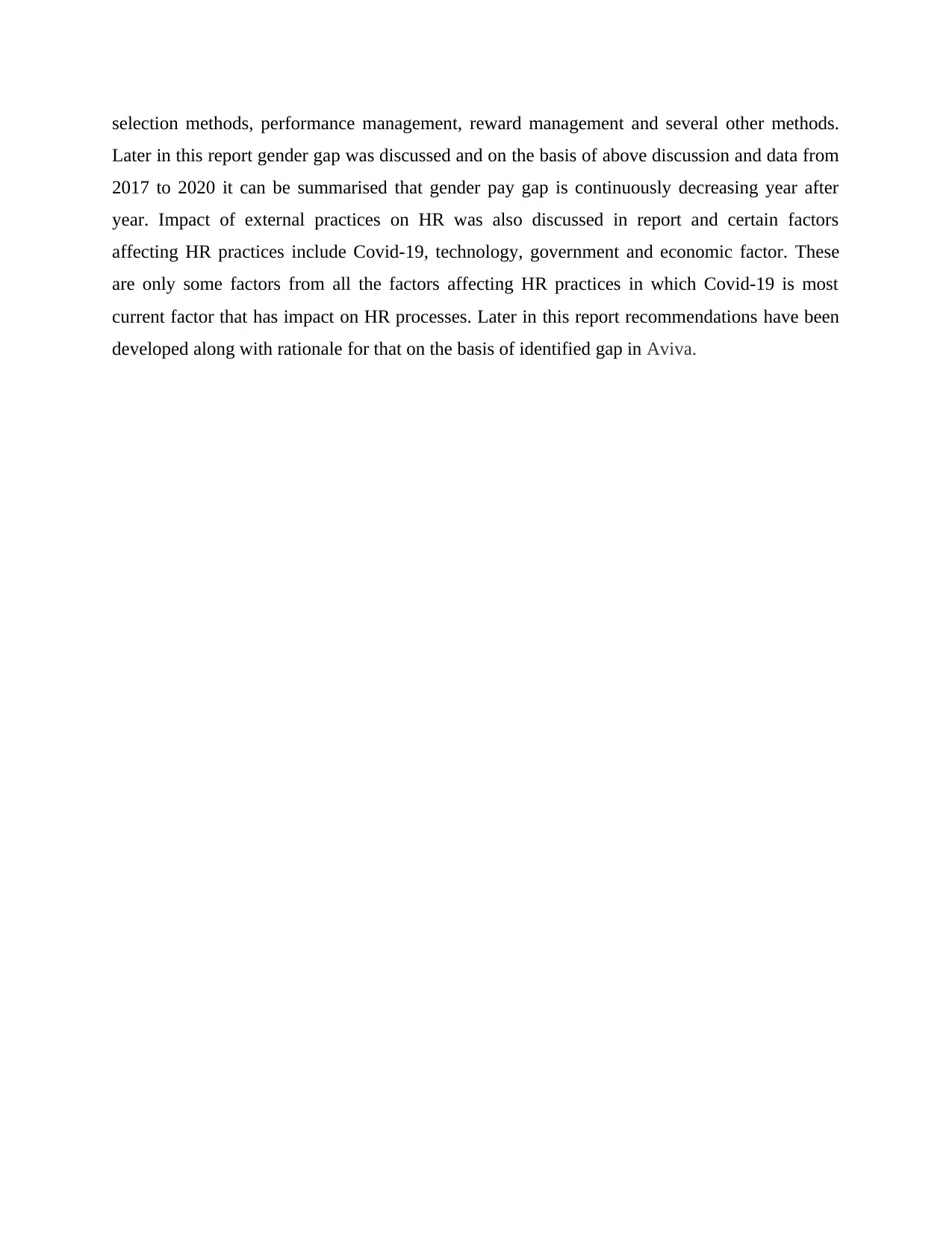
selection methods, performance management, reward management and several other methods.
Later in this report gender gap was discussed and on the basis of above discussion and data from
2017 to 2020 it can be summarised that gender pay gap is continuously decreasing year after
year. Impact of external practices on HR was also discussed in report and certain factors
affecting HR practices include Covid-19, technology, government and economic factor. These
are only some factors from all the factors affecting HR practices in which Covid-19 is most
current factor that has impact on HR processes. Later in this report recommendations have been
developed along with rationale for that on the basis of identified gap in Aviva.
Later in this report gender gap was discussed and on the basis of above discussion and data from
2017 to 2020 it can be summarised that gender pay gap is continuously decreasing year after
year. Impact of external practices on HR was also discussed in report and certain factors
affecting HR practices include Covid-19, technology, government and economic factor. These
are only some factors from all the factors affecting HR practices in which Covid-19 is most
current factor that has impact on HR processes. Later in this report recommendations have been
developed along with rationale for that on the basis of identified gap in Aviva.
Paraphrase This Document
Need a fresh take? Get an instant paraphrase of this document with our AI Paraphraser
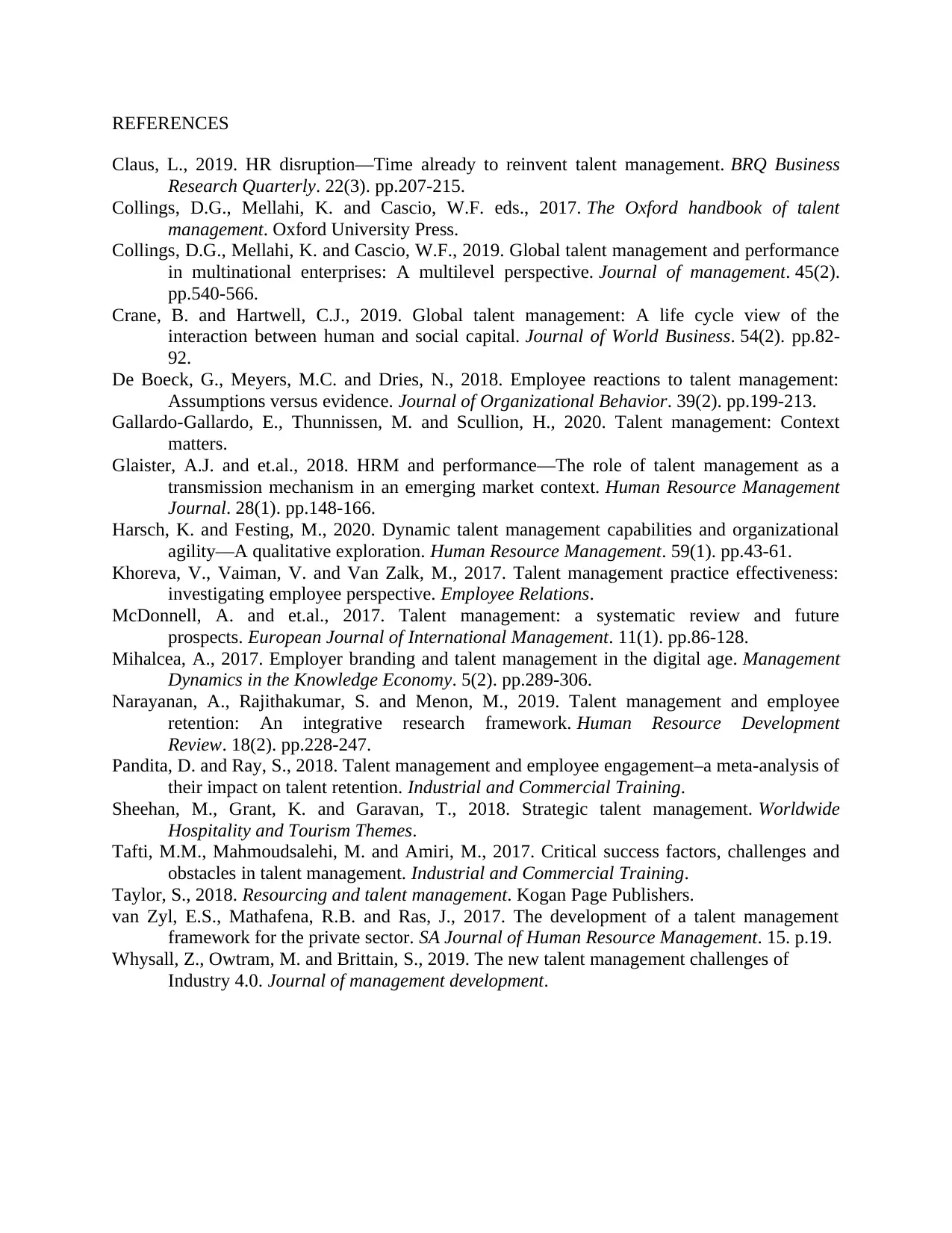
REFERENCES
Claus, L., 2019. HR disruption—Time already to reinvent talent management. BRQ Business
Research Quarterly. 22(3). pp.207-215.
Collings, D.G., Mellahi, K. and Cascio, W.F. eds., 2017. The Oxford handbook of talent
management. Oxford University Press.
Collings, D.G., Mellahi, K. and Cascio, W.F., 2019. Global talent management and performance
in multinational enterprises: A multilevel perspective. Journal of management. 45(2).
pp.540-566.
Crane, B. and Hartwell, C.J., 2019. Global talent management: A life cycle view of the
interaction between human and social capital. Journal of World Business. 54(2). pp.82-
92.
De Boeck, G., Meyers, M.C. and Dries, N., 2018. Employee reactions to talent management:
Assumptions versus evidence. Journal of Organizational Behavior. 39(2). pp.199-213.
Gallardo-Gallardo, E., Thunnissen, M. and Scullion, H., 2020. Talent management: Context
matters.
Glaister, A.J. and et.al., 2018. HRM and performance—The role of talent management as a
transmission mechanism in an emerging market context. Human Resource Management
Journal. 28(1). pp.148-166.
Harsch, K. and Festing, M., 2020. Dynamic talent management capabilities and organizational
agility—A qualitative exploration. Human Resource Management. 59(1). pp.43-61.
Khoreva, V., Vaiman, V. and Van Zalk, M., 2017. Talent management practice effectiveness:
investigating employee perspective. Employee Relations.
McDonnell, A. and et.al., 2017. Talent management: a systematic review and future
prospects. European Journal of International Management. 11(1). pp.86-128.
Mihalcea, A., 2017. Employer branding and talent management in the digital age. Management
Dynamics in the Knowledge Economy. 5(2). pp.289-306.
Narayanan, A., Rajithakumar, S. and Menon, M., 2019. Talent management and employee
retention: An integrative research framework. Human Resource Development
Review. 18(2). pp.228-247.
Pandita, D. and Ray, S., 2018. Talent management and employee engagement–a meta-analysis of
their impact on talent retention. Industrial and Commercial Training.
Sheehan, M., Grant, K. and Garavan, T., 2018. Strategic talent management. Worldwide
Hospitality and Tourism Themes.
Tafti, M.M., Mahmoudsalehi, M. and Amiri, M., 2017. Critical success factors, challenges and
obstacles in talent management. Industrial and Commercial Training.
Taylor, S., 2018. Resourcing and talent management. Kogan Page Publishers.
van Zyl, E.S., Mathafena, R.B. and Ras, J., 2017. The development of a talent management
framework for the private sector. SA Journal of Human Resource Management. 15. p.19.
Whysall, Z., Owtram, M. and Brittain, S., 2019. The new talent management challenges of
Industry 4.0. Journal of management development.
Claus, L., 2019. HR disruption—Time already to reinvent talent management. BRQ Business
Research Quarterly. 22(3). pp.207-215.
Collings, D.G., Mellahi, K. and Cascio, W.F. eds., 2017. The Oxford handbook of talent
management. Oxford University Press.
Collings, D.G., Mellahi, K. and Cascio, W.F., 2019. Global talent management and performance
in multinational enterprises: A multilevel perspective. Journal of management. 45(2).
pp.540-566.
Crane, B. and Hartwell, C.J., 2019. Global talent management: A life cycle view of the
interaction between human and social capital. Journal of World Business. 54(2). pp.82-
92.
De Boeck, G., Meyers, M.C. and Dries, N., 2018. Employee reactions to talent management:
Assumptions versus evidence. Journal of Organizational Behavior. 39(2). pp.199-213.
Gallardo-Gallardo, E., Thunnissen, M. and Scullion, H., 2020. Talent management: Context
matters.
Glaister, A.J. and et.al., 2018. HRM and performance—The role of talent management as a
transmission mechanism in an emerging market context. Human Resource Management
Journal. 28(1). pp.148-166.
Harsch, K. and Festing, M., 2020. Dynamic talent management capabilities and organizational
agility—A qualitative exploration. Human Resource Management. 59(1). pp.43-61.
Khoreva, V., Vaiman, V. and Van Zalk, M., 2017. Talent management practice effectiveness:
investigating employee perspective. Employee Relations.
McDonnell, A. and et.al., 2017. Talent management: a systematic review and future
prospects. European Journal of International Management. 11(1). pp.86-128.
Mihalcea, A., 2017. Employer branding and talent management in the digital age. Management
Dynamics in the Knowledge Economy. 5(2). pp.289-306.
Narayanan, A., Rajithakumar, S. and Menon, M., 2019. Talent management and employee
retention: An integrative research framework. Human Resource Development
Review. 18(2). pp.228-247.
Pandita, D. and Ray, S., 2018. Talent management and employee engagement–a meta-analysis of
their impact on talent retention. Industrial and Commercial Training.
Sheehan, M., Grant, K. and Garavan, T., 2018. Strategic talent management. Worldwide
Hospitality and Tourism Themes.
Tafti, M.M., Mahmoudsalehi, M. and Amiri, M., 2017. Critical success factors, challenges and
obstacles in talent management. Industrial and Commercial Training.
Taylor, S., 2018. Resourcing and talent management. Kogan Page Publishers.
van Zyl, E.S., Mathafena, R.B. and Ras, J., 2017. The development of a talent management
framework for the private sector. SA Journal of Human Resource Management. 15. p.19.
Whysall, Z., Owtram, M. and Brittain, S., 2019. The new talent management challenges of
Industry 4.0. Journal of management development.
1 out of 11
Related Documents
Your All-in-One AI-Powered Toolkit for Academic Success.
+13062052269
info@desklib.com
Available 24*7 on WhatsApp / Email
![[object Object]](/_next/static/media/star-bottom.7253800d.svg)
Unlock your academic potential
Copyright © 2020–2025 A2Z Services. All Rights Reserved. Developed and managed by ZUCOL.





